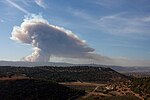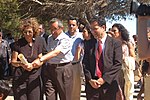The Mount Carmel Forest Fire (Hebrew: אסון הכרמל Ason HaKarmel, "The Carmel Disaster") was a deadly forest fire that started on Mount Carmel in northern Israel, just south of Haifa. The fire began at about 11:00 local time on 2 December 2010, and spread quickly, consuming much of the Mediterranean forest covering the region. With a death toll of 44, it was the deadliest civil disaster in Israeli history until the 2021 Meron stampede. Those killed included 36 Israel Prison Service members, most of them new recruits, as well as three senior police officers, among them the chief of Haifa's police, and three firefighters, among them a 16-year-old volunteer. More than 17,000 people were evacuated, including several villages in the vicinity of the fire, and there was considerable property and environmental damage.The fire appeared to be caused by human activity near the Druze town of Isfiya. On 6 December a 14-year-old resident of the town told police that he had inadvertently started the fire with a nargila coal. The teen's father argued that his son was witnessed in school at the time and could not have started the blaze.The fire was followed by a wave of arsons throughout Israel and the West Bank. These fires, which initially created confusion regarding the source of the Carmel blaze, were all extinguished within a few hours of being lit. The motivation for the attacks was not immediately clear. Israeli police have referred to some of these fires as arson.Government officials, including Prime Minister Benjamin Netanyahu and Foreign Minister Avigdor Lieberman, called on other countries to help assist in firefighting efforts, and the Israel Defense Forces mobilized troops for the same purpose. The fire was defeated on 5 December after raging for 77 hours, a little over three days.









